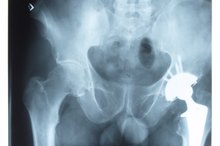Calcified Uterine Fibroid Symptoms
Uterine fibroids are the most common benign gynecologic tumors, affecting an estimated 25 percent of adult women 1. The tumor is an overgrowth of the myometrium, the muscular, middle layer of the uterus, resulting in the distortion of the normal architecture of the uterus. Specific etiology is not clear at this time, but there are common theories that include genetic predisposition, estrogen/progesterone and certain chemicals in the body, such as the insulin-like growth factor. Various risk factors are being examined--including African-American descent, obesity, nulliparity (never pregnant) and early oral contraceptive use.
Process of Calcification
The tumor can grow so fast and so large that it outgrows its own blood supply, resulting in a process of degeneration (hyaline degeneration). This degenerative process encourages calcium deposition, leading to calcification. During menopause, there is a tendency for these tumors to regress, with increased likelihood of calcification as degenerative changes take place.
Symptoms
Signs of Fibroid Degeneration
Learn More
Calcified fibroids are much quieter than the usual fibroid 1. Sometimes they're discovered upon routine radiological examination, when they are more prominent because of the calcium content. This may be the first sign. Symptoms vary with position and size, as with ordinary fibroids 1. The same palpable abdominal mass, rock-hard in the case of calcification, is seen. The clear difference here is the much-reduced severity of pain, as the calcified fibroid is no longer growing or likely to undergo any otherwise painful transformation. Pressure on supporting ligaments of the uterus, in the case of large or multiple fibroids, can lead to constant waist pain, worsened at the time of menstruation 1. There are subserous fibroids, located just under the outermost covering of the uterus 1. These have the tendency to impinge on neighboring structures, mainly the rectum behind and bladder in front. Thus, there could be constipation or diarrhea, urgency or incontinence. Actual impairments of kidney function have been reported with particularly heavy fibroids 1. Increased surface area of the uterus with occasional ulcerations of the endometrial lining are thought to be the reason for the bothersome menorrhagia, or increased menstrual bleeding seen in fibroids--particularly the submucous (just under the innermost lining), intramural (confined to the middle layer) and transmural (passing right through from outermost to innermost layers) variety 1. This could also explain the pesky intermenstrual bleeding in some cases. The presence of the fibroid in the lumen of the uterus encourages a hostile environment for implantation, thus preventing pregnancy. There is also actual blockage of access to the tubes in some cases. In actual pregnancies, there are increased incidences of surgical interventions, badly positioned or premature separation of the placenta, breech presentation and obstruction of labor.
- Calcified fibroids are much quieter than the usual fibroid 1.
- In actual pregnancies, there are increased incidences of surgical interventions, badly positioned or premature separation of the placenta, breech presentation and obstruction of labor.
Outlook
The calcified fibroid is the end stage of a degenerative process. Thus, there is hardly any other disease progression here. There can be no increase in size nor any new, otherwise painful, developments in a calcified fibroid. In fact, a significant number of fibroids treated with uterine artery embolization end up as calcified fibroids much later down the line 1.
- The calcified fibroid is the end stage of a degenerative process.
- There can be no increase in size nor any new, otherwise painful, developments in a calcified fibroid.
Related Articles
References
- Uterine fibroids
- Uterine fibroids: MedlinePlus Medical Encyclopedia. MedlinePlus. Nov 6, 2019.
- Uterine fibroids. womenshealth.gov. Apr 1, 2019.
- Stewart EA, Cookson CL, Gandolfo RA, Schulze-rath R. Epidemiology of uterine fibroids: a systematic review. BJOG. 2017;124(10):1501-1512. doi:10.1111/1471-0528.14640
- Stewart EA, Nicholson WK, Bradley L, Borah BJ. The burden of uterine fibroids for African-American women: results of a national survey. J Womens Health (Larchmt). 2013;22(10):807-16. doi:10.1089/jwh.2013.4334
- Ilaria soave, Marci R. From obesity to uterine fibroids: an intricate network. Curr Med Res Opin. 2018;34(11):1877-1879. doi:10.1080/03007995.2018.1505606
- Stewart, E.A. (2015). Uterine fibroids. N Engl J Med, 372, 1646-1655. doi:10.1056/NEJMcp1411029
Resources
Writer Bio
IkechiK is an international medical graduate with U.S credentials and over 15 years of general medical practice experience in diverse cultural backgrounds. He has been delivering health education talks and writing health related content during that period for diverse audiences, from small group periodicals to informational websites. Based in Alexandria, IkechiK is pursuing further studies in Preventive Medicine.








